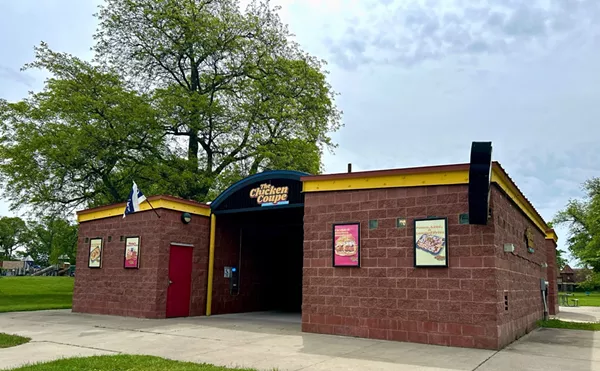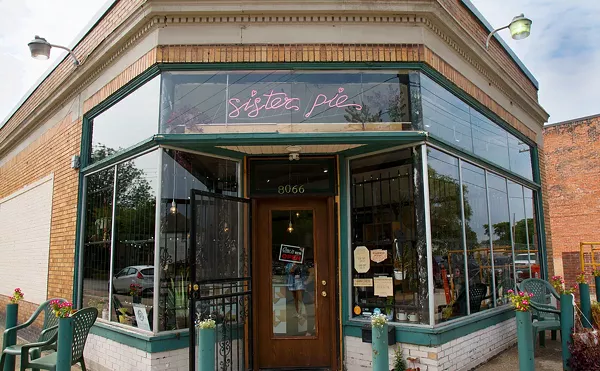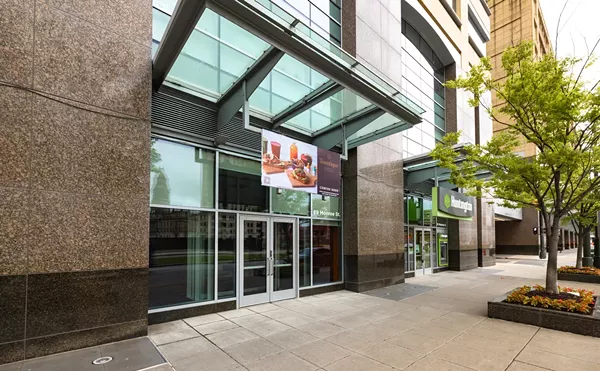
Audio By Carbonatix
[
{
"name": "GPT - Leaderboard - Inline - Content",
"component": "35519556",
"insertPoint": "5th",
"startingPoint": "3",
"requiredCountToDisplay": "3",
"maxInsertions": 100,
"adList": [
{
"adPreset": "LeaderboardInline"
}
]
}
]
When Americans consider eating Japanese, we tend to think of a) sushi and b) a certain stillness and tranquility, a quiet elegance where the decor and the presentation combine to enhance some complex and subtle flavors. But when Japanese salarymen go out after work — well, they’re looking for a place to drink.
Seems there are enough Japanese engineers in the northern burbs, here on three- to five-year stints, to keep a typical izakaya thriving. That’s a pub, as manager Ken Nagao explains it, with plenty of food to accompany the alcohol. "Lots of Japanese businessmen go out for drinks after work," Nagao told me, which is sort of like saying that the Pope is Catholic.
He serves five Japanese beers, and sake, of course, but the hot drink these days is stronger stuff, a clear liquor called sochu, distilled from barley, potatoes, rice or buckwheat. In Japan sochu has surpassed sake, and Hanzo has row upon row of frosted white bottles on display. Many customers drink it hot, in the belief that the heat prevents hangovers.
The unassuming place was still full at 10 p.m. on a recent Tuesday, suggesting that "after work" is an elastic category. Everyone except my companion and I were from the target demographic. Cooks toiled in the open kitchen behind the bar while groups of men shared plates. I was too shy to ask whether Mazda fraternized with Toyota.
The menu is divided into categories: seafood, noodles, sashimi and more. There’s no sushi. Nagao explains that sushi is just as expensive in Japan as here, if not more so; it’s not eaten every day. An izakaya serves the kind of food you might eat on a daily basis.
With one inexplicable exception, Hanzo’s food follows the Japanese model of graceful arrangements, complementary tastes and colors, and light but satisfying food.
Typical was wafu salad, which adds tofu and seaweed to your usual lettuce and tomato. The dark brown dressing is outstanding. Saba shioyaki is salty grilled mackerel with a crisp exterior. Nasuno agedashi is about the most vibrant eggplant dish I’ve tasted, soft and sweet and topped with ginger. Takosu is a beautiful but bland presentation of octopus in vinegar; the fluted snow-white slices are edged in mauve and accompanied by paper-thin cucumber slices swirled into a little tower.
Beef and tofu may seem an unusual combination to Westerners, associated as they are with carnivorous excess on the one hand and righteous vegetarianism on the other. But just about our favorite dish was simmered beef and tofu, nikutofu, in which the multilayered broth was the star.
Also fabulous was tempura soba, big, slurpy buckwheat noodles with fried shrimp in a tea-like broth. It’s fascinating how a broth, with only one texture going for it, can contain so many gradations of flavor.
Again excellent was a generous butano seiromushi, one of the 22 daily specials. It’s advertised as "bean sprouts and garlic stems wrapped with pork and steamed." Steaming doesn’t make pork a pretty color, but the thin, crunchy garlic slices are a delicacy. This dish is served with a complex ponzu sauce that incorporates red bean paste. Less interesting was kanino kouraage, crab stuffed in its shell: OK, but surprisingly one-note.
The antithesis of the Japanese model was a huge "pancake" called segiyaki. "Pork, egg and scallions grilled in a pancake" — sounds great, doesn’t it? I ordered it despite the next few words: "topped with mayo." It’s a charmer to look at, with scores of tiny bonito flakes scattered over and gently waving; you get the feeling the dish is alive and friendly. But it’s no pancake; the texture is almost inedible, a mushy monstrosity, a melange of indecipherable ingredients. The mayo squiggles are the least of its problems. And Nagao says it’s one of his most popular dishes.
Hanzo is owned by the same folks who run Sharaku, a few doors down, which is more upscale and thrives on expense account dinners. Sharaku is closer to an American stereotype of a Japanese restaurant — but Hanzo is doing just fine in its niche market. It’s the place folks go when they’re spending their own money.
Kitchen Hanzo is open only for dinner, Monday through Saturday. Cigarette smoke is in evidence.
Jane Slaughter dines for Metro Times. Send comments to letters@metrotimes.com.






